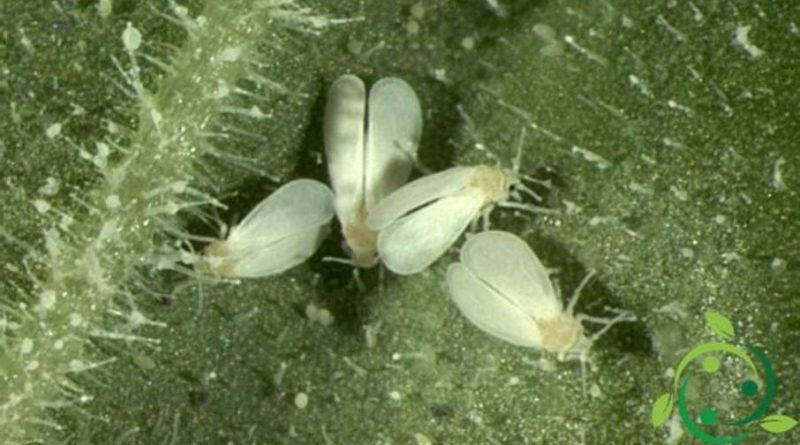Trialeurodes vaporariorum
Trialeurodes vaporariorum
The white fly, known as the greenhouse aleurodide (Trialeurodes vaporariorum (Westwood, 1856) is an insect of the Aleyrodidae family.
Systematics –
From the systematic point of view it belongs to the Domain Eukaryota, Kingdom Animalia, Sub-Eumetazoa, Phylum Arthropoda, Subphylum Hexapoda, Class Insecta, Subclass Pterygota, Coorte Exopterygota, Subcoorte Neoptera, Superorder Paraneoptera, Section Rhynchotoidea, Order Rhynchota, Suborder Homoptera, Section Sternorrhyncha, Superfamily Aleyrodoidea, Family Aleyrodidae, Subfamily Aleyrodinae and then to the Genus Trialeurodes and to the Specie T. vaporariorum.
Geographic Distribution and Habitat –
The Trialeurodes vaporariorum is an insect native to tropical areas but has spread throughout the world homogeneously, especially for the high reproductive potential and ability to adapt. Its diffusion took place especially in the production of greenhouses where the hot humid climate and poor ventilation create the best conditions for reproduction and, therefore, the greatest number of damages. From these passes also some outdoor crops especially in southern Italy.
Morphology –
The Trialeurodes vaporariorum is a small white midge with small wings, also white, which are parallel to the leaf surface (which makes them stand out from the Bemisia tabaci (where the wings are joined to the body); adults and T. vaporariorum pupae usually have a larger amount of waxy powder than B. tabaci.The juvenile forms of T. vaporariorum are of a flat, almost transparent white / yellowish color.
Attitude and biological cycle –
The Trialeurodes vaporariorum is positioned among the leaves, where small flies are seen flying; on the lower page you can see both adults and juveniles, as well as eggs. The complete life cycle of this white fly lasts between 15 and 40 days, depending on the humidity and temperature conditions: the eggs develop more rapidly at higher temperatures. The white fly usually lays the eggs on the underside of the leaves, where they are fixed. This insect can winter in different stages, outdoors, on spontaneous plants. In the greenhouse the generations, given the particular conditions, are practically continuous, without interruptions and with very fast cycles that can last 30 days. For this reason, in the greenhouse and above all in the open field, natural containment techniques must be adopted.
Ecological role –
The Trialeurodes vaporariorum being an insect native to the tropical areas finds in these habitats both the best conditions of growth but also the natural antagonists with which they generate equilibrium biocenosis. In climates where it has spread, far from the original areas, the ecological system favors it, so it is necessary to implement containment systems of various kinds. The first containment system is absolutely to reduce today the surfaces of greenhouses that, in addition to generating a significant ecological footprint for the production of equal quantities of agricultural product, have become privileged breeding grounds for the insect. The second system is to introduce into environments where its antagonists proliferate. In greenhouses or in other protected crops conditions, flooding flies of the Afelinide hymenoptera, Encarsia formosa can be successfully applied; this is a parasitoid of the juvenile forms of the Aleurode in which he lays an egg for an insect; parasitized nymphs are noticed because they become black. From each neanide will flicker an adult able to parasitize other nymphs (each female parasitizes about 50-60 nymphs of Aleurode). The threshold for the launch of the Enchanting horny should be done only after evaluating the presence of the plant, in the ratio of 4-5 parasitoids (pupars) per m2 of greenhouse, repeating the launches 4-6 times, weekly until obtaining a parasitization of 60-80%. But this is a situation that does not tend to balance, because in our climates and our conditions the E. curvy is not acclimated. Other remedies can be implemented with the predator Macrolophus caliginosus and the Chrysoperla carnea which, although specific predator of Aphids, carries out a collateral action also against the white fly of the greenhouses. Other antagonistic insects could also contain this small fly, as well as the chromotropic traps can perform an additional action to contain the T. vaporariorum. The solution that rebalances the entire system must be sought, however, as mentioned above, in natural containment techniques.
Guido Bissanti
Sources
– Wikipedia, the free encyclopedia.
– Russo G., 1976. Agricultural Entomology. Special Part. Liguori Editore, Naples.
– Tremblay E., 1997. Applied entomology. Liguori Editore, Naples.

